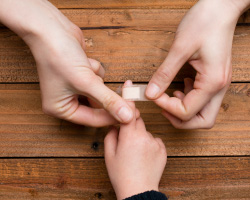
When you get a cut, you want to help it heal well. A few simple steps are usually all you need.
The following tips for treating a cut are based on information from the American Academy of Family Physicians and the American Academy of Pediatrics:
- To stop bleeding, put continuous pressure on the cut with a clean cloth, tissue or gauze. Place more material on top if blood soaks through, and continue to apply pressure.
- To wash a cut, use cool water with a little soap for the skin around the wound and tweezers cleaned in isopropyl alcohol to remove any remaining dirt. You don't need a strong cleanser such as hydrogen peroxide or antiseptic. If the cut is large, you can't remove all of the dirt, or bleeding continues after 10 minutes of direct pressure, go to the emergency department.
- Use a clean, dry bandage to keep the cut clean and avoid infection. Most minor cuts heal well without antibiotic ointment. Use an adhesive strip or gauze and adhesive tape, and change it daily. After a scab forms, leave it alone until it falls off on its own.
- A cut may require stitches if it's gaping, longer than a half inch or located on the face.
You may need a tetanus shot to prevent a serious infection. Call your doctor after a clean cut if you haven't had a tetanus shot in 10 years. Call after a dirty cut if you haven't had a tetanus shot in the last five years.
Call a doctor if the cut becomes red, swollen, tender, warm or begins to drain.
It's always a good idea to have a well-stocked first aid kit in your home and vehicle. You can find recommendations for what to include in a kit on the American Red Cross website.
Reviewed 9/5/2025